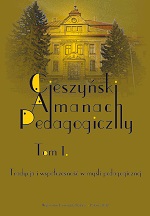Działalność zakonna w zakresie kształcenia i wychowywania dzieci i młozieży w okresie międzywojennym i w nowej rzeczywistości kształtującej się...
The Role of monastic Orders in Educating and Upbringing Children and Adolescents in the years between WW I and WW II and in the rew reality of the....
Author(s): ks. Tomasz ŻołnaSubject(s): Psychology
Published by: Wydawnictwo Uniwersytetu Śląskiego
Summary/Abstract: When the model of a citizen of independent Poland was being created after the First World War, a very important role in the process was play.ed by the Church, first of all by its monastic orders. It was an obvious consequence of the fact that during the partition years it was mainly the Church that took care of the patrotic and moral attitudes of the society. A case in point is the activity of the Sisters of Mercy of St Borromeo in the Polish province of Silesia, where the Sisters ran mainly orphanages and nursery schools. After the Second World War, new legislation introduced by the communist government made it impossible for the Church to continue educating and bringing up children according to the principles worked out in the pre-war era. When the Sisters of Mercy and other women orders tried to resume their educational or welfare activities, they met with severe restrictions and finally were completely excluded from the process of educating young people. The decline of the repressive political system in the 1980s meant that different religious orders and organisations could return to teaching, which they had had to abandon in the two decades after WW II.
Journal: Cieszyński Almanach Pedagogiczny
- Issue Year: 2012
- Issue No: 1
- Page Range: 98-115
- Page Count: 18
- Language: Polish
- Content File-PDF

